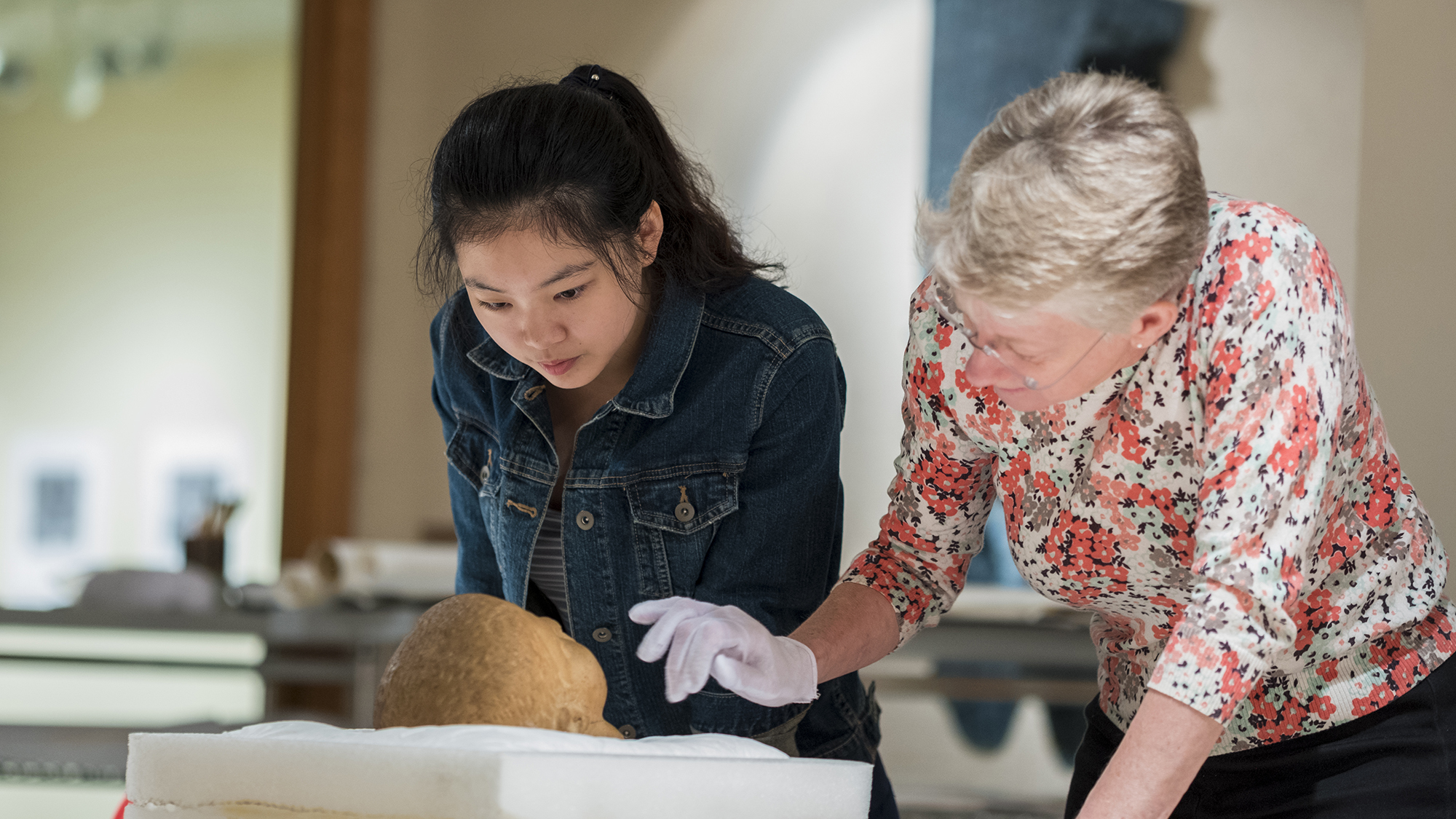Why Should We Study the Humanities?
Read also:
As new learning spaces dedicated to humanities and social studies rise up on the Grinnell campus, so are conversations springing up about what those disciplines commonly identified as “the humanities” mean to our lives.
The Grinnell Magazine assembled a group of tenured professors in the College’s humanities division for a roundtable discussion to share their thoughts. Participants included Monessa Cummins, associate professor of classics; Caleb Elfenbein, associate professor of history and of religious studies and director of the Center for the Humanities; Jin Feng, professor of Chinese, Orville and Mary Patterson Routt Professor of Literature; Lee Running, associate professor of art; and Erik Simpson, professor of English, Samuel R. and Marie-Louise Rosenthal Professor of Humanities. The conversation has been edited for length and clarity.
Are the humanities still relevant?
Grinnell Magazine: What do you see as the future for the study of the humanities, their continued relevance to the liberal arts experience, and their impact on students’ overall life satisfaction?
 Erik Simpson, professor of English, Samuel R. and Marie-Louise Rosenthal Professor of Humanities:
Erik Simpson, professor of English, Samuel R. and Marie-Louise Rosenthal Professor of Humanities:
Part of what we do will involve responding to technological change, which creates new problems of understanding how cultural materials are created and received. If you get words and images from Facebook, to pick the most obvious example, you may not understand how they’re coming to you, in a pretty fundamental way. … To me, it makes the humanities all the more important for understanding and responding to the way our culture is being processed for us.
 Monessa Cummins, associate professor of classics:
Monessa Cummins, associate professor of classics:
I think one of the things humanities brings is a perspective to say, you know, the world’s always been somewhat chaotic and perplexing. And it’s not really a whole lot worse now than it was 2,000 years ago.
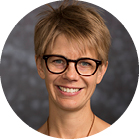 Lee Running, associate professor of art:
Lee Running, associate professor of art:
How do we remain observant? How do we remain informed? How do we remain in dialogue inside of a system that is in flux? And I think the training for that feels inherently humanistic to me.
 Jin Feng, professor of Chinese, Orville and Mary Patterson Routt Professor of Literature: I also think this really is the hope of the humanities. We don’t necessarily train people to become a surgeon; of course they can become a surgeon, right? But that’s not the goal we have in mind when we start.
Jin Feng, professor of Chinese, Orville and Mary Patterson Routt Professor of Literature: I also think this really is the hope of the humanities. We don’t necessarily train people to become a surgeon; of course they can become a surgeon, right? But that’s not the goal we have in mind when we start.
I think it gives us a certain suppleness in emotional and intellectual muscles. … It helps you to understand yourself, and then understand your relationship with other people. By doing that you understand others. Understand people. That is a life skill. …
We teach students how to do critical thinking, to question the source of this information. Is that sent by a robot? That sort of thing. That is very, very practical, too. And this gets back to your question about satisfaction. Maybe happiness is not the right word, because that may not be the ultimate goal of an education. But you can enrich your life so much by doing the humanities. To be a full human being. To be a complete human being. Even though it’s messy. Even though it’s chaotic.
That’s how I see it. It teaches people wisdom.
Cummins: I’m not sure I want to say this — I’m not pushing for the practical value of humanities — but there is a practical byproduct of what we do, that I think serves our students very well when they go out into the world. We don’t have to preach it, we just have to enforce the apprenticeship and the learning of the skills and the listening, and they learn and they walk away much more discriminating and much more patient.
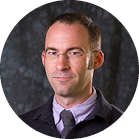 Caleb Elfenbein, associate professor of history and of religious studies and director of the Center for the Humanities:
Caleb Elfenbein, associate professor of history and of religious studies and director of the Center for the Humanities:
I do think that an essential part of the experience of our students is seeing all of us continue to wrestle with these problems and to have a conversation like this one, where we’re all repeatedly saying that we’re learning in the process of this conversation. And that we’re learning in the process of larger conversations that we’re a part of and in collaboration with each other. That’s been so important in my life here, that I’m trying to figure out what it is to be a humanist in a context where we’re all figuring that out together.
Feng: And there is also the larger context outside of this College, outside the bubble, so to speak. And at tumultuous times, at chaotic times, how to hold onto the center, right? So that’s something we also would like our students to learn, as we are learning ourselves.
There’s still hope. Don’t lose heart if you study the humanities. You’ll see, across history, there are cycles. There is always chaos, wars, suffering, and so on and so forth. But we move forward.
Cummins: Yes, and that message can be profoundly inspiring, and profoundly depressing. The cycle continues.
Elfenbein: I’ve really been thinking a lot about what role we, as humanists on the faculty, have in helping students think about what is happening right around us. Is this something that we bring up explicitly in classes? Is this something that we hope that filters through what we’re talking about? And what we’re seeing, especially around bias-motivated incidents. These are things that, as humanists, we are saying students will learn about difference. Where do the humanities fit here? Where do we, as humanists, fit here?
Feng: I think there are lots of emotional forces at play when we engage with other people. It’s not just about ideas. It’s, if I feel you don’t respect me, then I take offense. That happens quite often. So it’s the individual level as well as the system, the big picture. And we can only start with the individual. We cannot jump up to the whole national level all at once.
We do class discussion. We do debate in class. That’s one way to model, to guide students, to lead them to learn an effective way, or a more civil way of engaging with different opinions. And it’s a safe place, in a classroom.
Cummins: I have, at times, brought contemporary events into the classroom, or things on campus into the classroom, but I tend not to because I agree with Jin, that if you value honest disagreement in the classroom, if you teach students how to sit and be quiet and listen to something they may not agree with, but wait patiently for their turn to speak, that you are building up the habits that they will turn to when they confront these things outside the classroom.
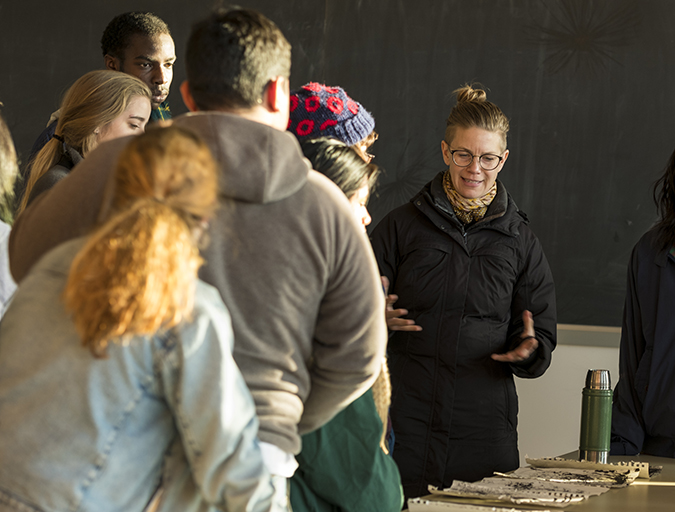
Running: The question of critique, too, I think is such an interesting one. … I think, for a class to come together and develop a set of critique standards — like, how are we going to speak to each other about these things that we have made together — is a really important skill for them to develop with each other because it is not imposed from outside. Here are four drawings together, each made by a different individual, each created with the same materials, same time limit. Four very different images in front of us. How do we talk about what these are? How do we evaluate?
Elfenbein: When I think about what the humanities have to offer when we’re thinking about difference, for example, my mind immediately jumps to content. But it’s really interesting that from each of you I’m hearing about pedagogy, and humanistic pedagogies, and actually how essential they are to laying the groundwork for effective engagement with the world. And I use “effective” very purposefully there.
Cummins: But I don’t have that goal in mind. Those are byproducts of the intellectual action in the class, if you see what I mean. Simultaneously I tell students, you will have skills that you can use in the marketplace, but that’s not why I do it.
Elfenbein: I’m not even thinking marketplace. I’m thinking in the dorm, as we watch our students really struggle with how to work through these very present questions around difference, diversity.
Simpson: I think we’ve talked mostly about the way we choose to respond to those prompts in the classroom. But, of course, a lot of our connections with students are one-on-one, too, and those come from the way we communicate with all of our students about our availability and the way we make ourselves present on campus. Not only in the classroom, but in a lot of other ways with students when we know that they’re struggling. I take that to be a very important part of my job, and a part that I do think that my training in the humanities has helped prepare me for: reading widely, understanding where a lot of different people are coming from, having the humility to know that my understanding is imperfect and that I need to listen.
On the value of well-designed learning spaces
Grinnell Magazine: Soon you will be teaching and collaborating in learning spaces designed specifically for the humanities and social studies community, in the Humanities and Social Studies Center (HSSC). How important is this?
Cummins: It’s really important to me in a really basic way. I teach Greek and Roman art and archaeology to 20 students in a classroom which has seating for 15 at a table. There are the people at the seminar table, and then there’s a line of people sitting in straight-backed chairs against the wall. It creates very much a first- and second-class feel. And I tell them they have to move back and forth between the table and the chairs so that it doesn’t feel like a group of insiders and spectators on the outside.
When I go into the new building, I have profound hopes that I will be teaching in one of the case study rooms, where there will be horseshoe seating in two tiers, where my students can all see each other. No one is second class, and they can all see the images. I can lecture when it’s appropriate and move seamlessly to discussion, and they will all see each other. I look forward to that experience.
Feng: The new building certainly will help improve our teaching space and growing space. But I also look forward to this idea of collaboration between different departments, the neighborhood idea.
[There will be scientists], art historians, and people moving into the new building to work with faculty members in the humanities and the social sciences to work on projects for a certain period of time. I certainly look forward to that because I really like interdisciplinary teaching and interdisciplinary research. Maybe some team-teaching idea will come out of that as well.
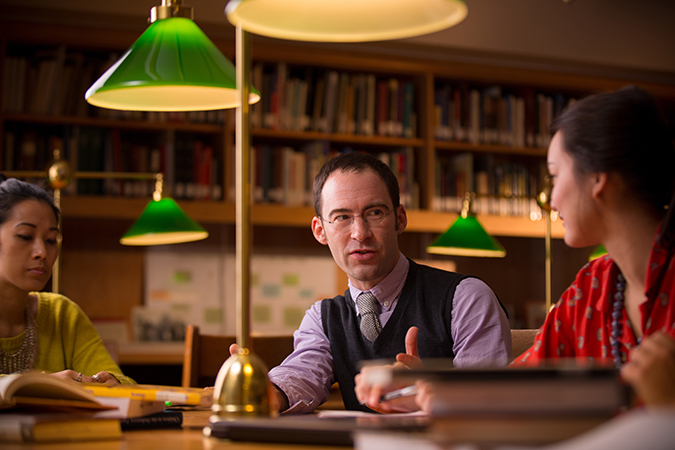
Elfenbein: Having taught in very different spaces [across campus] really brought into relief the effect that space has on the way that we teach and the experience that students have because of the placement of what was a very small screen. I couldn’t project documents that I wanted to serve as a basis for discussion. In other classrooms, I haven’t been able to leave documents up to serve as a reminder and an inspiration as we’re having discussion, because I can’t have that screen down and use the chalkboard.
So, just the flexibility that these spaces will provide will really be a difference-maker for me in my teaching. I’ve also found that, to honor the fact that students have very different ways of working up to participating in large classes, that having spaces that smaller groups can go and talk with some privacy, to formulate their thoughts, to say things that they might not have the courage to say in front of 26 other people, that’s really important to their experience, and to, ultimately, the kinds of discussions that we have in class.
[Also] I would say that, in my experience of teaching in Steiner Hall, for example, or in ARH, where there really isn’t great public space, this building is going to make a big difference where people are hanging out or talking to each other, and they can sit and do that.
I think that is really significant in trying to imagine how, as a community, we function. Where is the public space right now? It’s the [Spencer] Grill, it’s some parts of Noyce [Science Center]. But I don’t know where else that is. And I’m actually really excited about having it.
Simpson: I think the café is going to be really important, too — to have an informal, unplanned gathering space that is within the humanities and social studies communities.
Feng: I see that improved teaching and learning space can not only aid our teaching, but maybe also inspire our teaching through exploration of new pedagogical tools and methods and such.
Cummins: I am beginning, now that it’s actually taking shape, to feel excitement about seeing other colleagues. The dean was savvy, at least for classics. There are only four of us, and he divided us in two pairs. Two relatively closer to each other and two further down the hall, but relatively close to each other. And then, I believe English and history will somehow be interspersed. I don’t know who we’re getting, but it’s exciting to think about who those other people might be, because there’s enough proximity that we can feel cohesion as a department, and yet there’s a little bit of excitement about whom might I see and talk to that I don’t otherwise, and what may happen.
And in conclusion
Grinnell Magazine: Final thoughts?
Cummins: I would stress, in spite of the fact that this was about the humanities, the commonalities that we have with our colleagues in social studies and science. They too are vigorously involved in examining the human condition. They too care about all the things we care about. The knowledge they pursue may have different methodologies, but their teaching and their mission, I think, is the same as ours in the end. Human knowledge.
Simpson: It is a huge advantage, at this institution, that we do have that sense that we’re all on the same team, that we’re all interested in the liberal arts.
Cummins: We are all components of the liberal arts. All of us together.
Feng: I think we should not lose heart because we, as humanists, specifically, but as instructors or professors of liberal arts colleges, we do teach resilience. We teach emotional resilience. We teach endurance. We teach hope. So this sounds, maybe, too amorphous, but —
Simpson: I just voted for you.
[laughter]
Feng: — it explains what we are doing. I think we should also have the courage to say what we believe in. Sometimes students are conflict-averse. They do not want to disagree with other people. Sometimes they do not dare to, or feel uncomfortable, sharing their thoughts that other people would disagree with. That happens in my class as well. But I would really encourage people to say what they think. Then we can have some real engagement.
Cummins: I get that thing about crisis, but I experience a lot of hunger on the students’ part in the classroom. Hunger. They want something to think about. Then we have an obligation to offer what we have.
Feng: Yes, sometimes they also seek rules because it’s so much chaos outside. They want to follow certain paths. I think we could provide that, but also encourage them to explore on their own.

